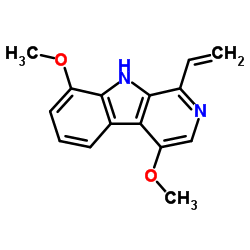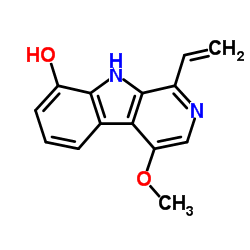4,8-Dimethoxy-1-vinyl-9H-β-carboline
Modify Date: 2025-09-11 18:10:47

4,8-Dimethoxy-1-vinyl-9H-β-carboline structure
|
Common Name | 4,8-Dimethoxy-1-vinyl-9H-β-carboline | ||
|---|---|---|---|---|
| CAS Number | 65236-62-6 | Molecular Weight | 254.284 | |
| Density | 1.3±0.1 g/cm3 | Boiling Point | 491.8±40.0 °C at 760 mmHg | |
| Molecular Formula | C15H14N2O2 | Melting Point | N/A | |
| MSDS | N/A | Flash Point | 174.9±17.6 °C | |
Use of 4,8-Dimethoxy-1-vinyl-9H-β-carbolineDehydrocrenatidine, a natural alkaloid, is a specific JAK inhibitor. Dehydrocrenatidine inhibits voltage-gated sodium channels and ameliorates mechanic allodia in a rat model of neuropathic pain[1][2]. |
| Name | 1-ethenyl-4,8-dimethoxy-9H-pyrido[3,4-b]indole |
|---|---|
| Synonym | More Synonyms |
| Description | Dehydrocrenatidine, a natural alkaloid, is a specific JAK inhibitor. Dehydrocrenatidine inhibits voltage-gated sodium channels and ameliorates mechanic allodia in a rat model of neuropathic pain[1][2]. |
|---|---|
| Related Catalog | |
| In Vitro | Dehydrocrenatidine inhibits JAK-STAT3 dependent DU145 and MDA-MB-468 cell survival and induces cell apoptosis. Dehydrocrenatidine inhibits JAKs-JH1 domain over-expression induced STAT3 and STAT1 phosphorylations[1]. Dehydrocrenatidine diminishes IL-6, IFNα and IFNγ stimulated STAT3 phosphorylation as well as constitutive STAT3 phosphorylation[1]. DHCT suppresses both tetrodotoxin-resistant (TTX-R) and sensitive (TTX-S) voltage-gated sodium channel (VGSC) currents with IC50 values of 12.36 µM and 4.87 µM, respectively[2]. |
| In Vivo | Dehydrocrenatidine inhibits JAK-STAT3 dependent DU145 and MDA-MB-468 cell survival and induces cell apoptosis. Dehydrocrenatidine inhibits JAKs-JH1 domain over-expression induced STAT3 and STAT1 phosphorylations[1]. Dehydrocrenatidine diminishes IL-6, IFNα and IFNγ stimulated STAT3 phosphorylation as well as constitutive STAT3 phosphorylation[1]. DHCT suppresses both tetrodotoxin-resistant (TTX-R) and sensitive (TTX-S) voltage-gated sodium channel (VGSC) currents with IC50 values of 12.36 µM and 4.87 µM, respectively[2]. |
| References |
| Density | 1.3±0.1 g/cm3 |
|---|---|
| Boiling Point | 491.8±40.0 °C at 760 mmHg |
| Molecular Formula | C15H14N2O2 |
| Molecular Weight | 254.284 |
| Flash Point | 174.9±17.6 °C |
| Exact Mass | 254.105530 |
| PSA | 47.14000 |
| LogP | 3.70 |
| Vapour Pressure | 0.0±1.2 mmHg at 25°C |
| Index of Refraction | 1.703 |
| InChIKey | LDWBTKDUAXOZRB-UHFFFAOYSA-N |
| SMILES | C=Cc1ncc(OC)c2c1[nH]c1c(OC)cccc12 |
| Hazard Codes | Xi |
|---|
|
~% 
4,8-Dimethoxy-1... CAS#:65236-62-6 |
| Literature: Ohmoto; Koike; Higuchi; Ikeda Chemical and Pharmaceutical Bulletin, 1985 , vol. 33, # 8 p. 3356 - 3360 |
| Precursor 2 | |
|---|---|
| DownStream 0 | |
| 9H-Pyrido[3,4-b]indole, 1-ethenyl-4,8-dimethoxy- |
| 4,8-Dimethoxy-1-vinyl-9H-β-carboline |
| 8-O-methylpicrasidine I |
| 1-ethenyl-4,8-dimethoxy-9H-β-carboline |
| Dehydrocrenatidin |



